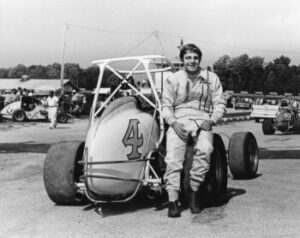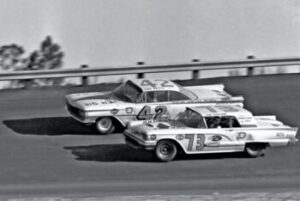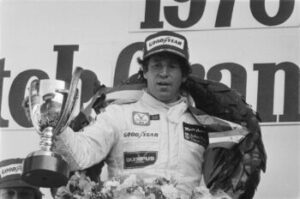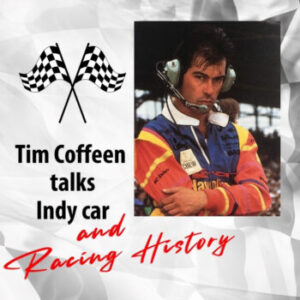Today I’m going to talk about a guy who seemingly came out of nowhere in the late 1960s and burst onto the American open-wheel racing scene. In August 1968, he won the first USAC Midget Race he ever drove in. Then in April of 1969, he won the Astro Grand Prix, a USAC Midget Race held at the Houston Astrodome. There were 22 IndyCar drivers entered.
He went on to win a total of eight Midget features that year. In 2006, Lee was inducted into the National Sprint Car Hall of Fame. In my humble opinion, he should also be in the National Midget Auto Racing Hall of Fame.
Lee obviously possessed a magnificent natural talent and it seemed like the sky was the limit. But in the course of those three and a half years, he also had two horrific accidents, where he suffered some devastating injuries and burns that would have ended most any other race car driver’s career. And yet, he came back, and this is his story.

Lee Kunzman: An American Racing Legend
Lee grew up in Guttenberg, Iowa, on the banks of the Mississippi River in Northeast Iowa. His family owned a Chevy Olds GM truck dealership there. As a kid, he listened to the Indy 500 on the radio, which sparked an interest in racing.
When he was a teenager, Lee attended an IMCA Sprint Car race in West Union, Iowa. Bobby Grim won the race, Lee caught racing fever, and from that day forward he knew he wanted to be a racing driver. In Iowa, it seems like there’s a fairground dirt track in almost every town, so Lee built his own dirt track late model and started racing.
In a relatively short period of time, young Lee Kunzman won championships at Hawkeye Downs in Cedar Valley, Iowa, racing against some tough competition. How tough was the competition? One of the drivers Lee raced against was Johnny Beauchamp. One night after a race, Beauchamp came into Lee’s pit, pushed him out of the way, reached into Lee’s car, and tore his rearview mirror off.
“Now you’ll start looking down the track, not behind you, and you’ll start winning races,” Beauchamp said to Lee.
Lee says it made him more focused and a better race driver. When Lee told me about that incident, the name Johnny Beauchamp sounded familiar, so I did a little research. In 1959, at the very first Daytona 500, Johnny Beauchamp had taken the checkered flag in a photo finished with Lee Petty. Beauchamp was declared the winner, but two days later, NASCAR reversed the result and gave the win to Petty.

Joining IMCA Sprint Car Racing
In early 1967, Lee started racing IMCA Sprint Cars for Merle Heath. He ran a couple of races with good results and they decided to travel over to Indiana for the Little 500 Sprint Car race, even though Lee had never driven on pavement. He qualified for the race and drove 500 laps with no relief, and no power steering, and was named Rookie of the Year. To this day, Lee says he remembers very little about that night because he was so tired.
Back to IMCA where Lee finished seventh in the championship and was named IMCA’s Rookie of the Year. The next season, 1968, Lee finished second in the points standings. IMCA was plenty tough competition, and in those days was considered one of the roads to USAC and the Indy 500
This was evidenced by the fact that A.J. Foyt, Parnelli Jones, Jim Hurtubise, Johnny Rutherford, Jim McElreath, Don Branson, Jud Larson, Bobby Grim, and Jan Opperman all raced in IMCA before going on to USAC and the Indy 500.
In August of 1968, Lee went to Davenport, Iowa as a spectator to watch a USAC Midget Race, hoping to see his childhood hero Bobby Grim race. But Grim didn’t show up. Lee had raced his stock car at Davenport.
He talked to USAC into granting him a temporary permit and got a ride in Grim’s vacant seat. Lee qualified well and transferred to the feature. In the main event, Lee worked his way up to third behind Bob Tattersall and Mel Kenyon. They were both running in the middle groove, so Lee started running low and found some moisture.
He admits he bumped into Tattersall to get around him and then passed Kenyon for the win. While Lee and his crew were celebrating in Victory Lane, Bob Tattersall grabbed ahold of him and said, “Don’t ever do that to me again.” And then he winked and said, “By the way, good job on Kenyon.” And to think, Lee had never sat in a USAC Midget before that night.
Manzanita Speedway
After Davenport, Bob Trostle, a legendary sprint car builder and owner, called Lee and offered him a ride at the first Western States Championship to be held at Manzanita Speedway in Phoenix. There were over 100 entries for the three nights of racing.
It’s no longer there, but in my opinion, Manzanita was one of the fastest and most demanding half-mile racetracks anywhere. In the main event, Lee was running third but suffered a flat tire.
His crew changed the tire, he went to the back and came through the field to finish sixth. At the conclusion of the West Coast trip, Trostle told Lee to go run USAC in 1969. After all, his ultimate goal was to race in the Indy 500.
Astro Grand Prix
In April 1969, Bob Wiley, the owner of the midget Lee had won with at Davenport, called and offered him a ride at the Astro Grand Prix inside the Houston Astrodome where 22 IndyCar drivers were entered.
Foyt, Mario, Bobby and Al Unser, Billy Vukovich, Gary Bettenhausen, Jim McElreath, Lloyd Ruby, and Johnny Rutherford. They were all there. Two days of racing drew 50,000 fans. In Sunday’s main event, Lee started mid-pack and methodically worked his way to the front. He came away with a convincing win. When recalling the Astrodome, Lee grinned and said, “I guess the new kid on the block made a statement.”

Midget vs. Sprint Cars
As mentioned earlier, Lee went on to win a total of eight USAC Midget features and also started running USAC sprints in 1969. He ran up front in the sprint cars, leading races and finishing seconds and thirds, but he didn’t win. I asked Lee how he could get in a midget, having never driven one, and win two of the first three races he drove in against some incredibly tough competition. His response?
“I can get in a Midget and nobody intimidated me. I felt I was equal with anybody as soon as I got in the car. But Sprint Cars are different. It took me damn near a full season of leading or running second to get the feeling internally that I could run with anybody. And when I figured it out, I loved racing Sprint Cars. They were my absolute favorite cars to drive.”
Chance at IndyCar Racing
At the end of 1969, J.C. Agajanian called Lee and offered him a ride in an IndyCar at the season finale to be held at Phoenix International Raceway as Billy Vukovich’s teammate.
There were 44 cars entered and Lee qualified 9th quick. During the race, he was forced to make a long pit stop, but he brought the car home for a 12th-place finish. When you consider the number of cars entered, and the fact that Lee had never even sat in a rear-engine turbocharged Offenhauser IndyCar, I find it remarkable that he qualified in the top 10 and finished in the top 12 overall. Especially because this was one of the fastest and most demanding tracks anywhere.
When asked about his IndyCar debut, he responded with typical Kunzman humility:
“I had no idea what I was doing. So in that case, ignorance was bliss.”
With 1969 coming to a close, his lifelong dream of racing at Indianapolis was just over the horizon. May of 1970 was a tough month at the Speedway for Lee. He drove the Joe Hunt Gerhardt-Offy in a team struggle with engine problems.
He finally passed his rookie test and had the speed to qualify, but every qualification attempt failed because of persistent engine problems. Undaunted, Lee went to Indianapolis Raceway Park and won the night before the 500 Midget Race.
Lee's Life Changed Forever
The next USAC Sprint Car race at I-70 Speedway in Odessa, Missouri would change Lee’s life forever. He switched rides and didn’t drive his regular Sprinter.
Lee qualified well and won his heat race and was charging through the field when his throttle stuck wide open. The car slammed into the wall, tore down a 10-foot fence, and burst into flames. Lee knew he was on fire and soaked with fuel. He crawled away from the car and tried to run to a fireman but realized his neck was broken because he said his legs went one way and his head went the other. Through this, he never lost consciousness.
Doc Dunseth came to the scene and gave Lee a shot. At a concession stand, Doc found a trough-like tank full of water and ice, laid Lee in it for buoyancy, and held his head and neck while they were transported by ambulance to the Kansas City Medical Research Center. To this day, Lee says the only reason he isn’t paralyzed is because of Doc Dunseth. The medical diagnosis was frightening. He had third-degree burns over 40% of his body.
His nose, eyelids, and lower lip were burned off, and he had second-degree burns over 20% of his body. In addition, the impact had broken his neck, his right arm, and his right wrist. Initially, surgeons wanted to amputate Lee’s right hand, but his dad intervened and refused to let them do it. He began skin grafts and physical therapy, and for the first few weeks, Lee kept a positive attitude.
But then, he now admits, self-sympathy began creeping in. And this is where one of Lee’s doctors stepped in and helped change the course of his life. The doctor told Lee he wanted him to start assuming responsibility by delivering mail to different wards in the hospital. This would require a nurse to push him in a wheelchair. As she wheeled him into a ward with the mail, Lee noticed the room was full of young men with missing limbs, many of whom were horribly burned from napalm.
This was during the height of the Vietnam War, and these young soldiers and Marines were casualties of that conflict. This experience changed Lee’s life forever.
To quote Lee: “Most of them had been drafted and had no say so in what happened to them. They answered the call and were serving their country. I’d been injured doing what I wanted to do. From that moment on, I never looked back. I had to figure out how to get back in a race car and what stepping stones I needed to take to get there.”
Lee's Racing Comeback
April 25th, 1971 was Lee’s racing comeback and it was spectacular. USAC wouldn’t grant Lee a license because they told him he had not fully recovered from his Odessa injuries. Determined to get back in the saddle, he went to Cincinnati, Ohio, and talked Howard Linne into letting Lee hot lap Howard’s midget. He had to borrow a helmet from another driver for practice and qualifying and then he dominated the feature event.
But when he pulled into Victory Lane, he was so tired that he couldn’t get the car out of gear and almost ran over a couple of USAC officials. And one can only imagine the shocked look on their faces when he pulled his helmet off. The guy they wouldn’t give a license to had just won the feature. They did give him his license back.
Lee said, “It sure felt good to be back in Victory Lane.”
In his comeback year, he won three midget races and captured his first USAC sprint car victory at Reading, Pennsylvania.
Lee's First Indy 500
Lee qualified for his first Indy 500 in 1972 and ran in a total of nine championship races with a fourth at Milwaukee and a fifth at Michigan as the best results. He was on his way. In USAC sprints, he finished third in points, winning five races, including three in a row on both pavement and dirt. He says the night he beat Pennsylvania legend Mitch Smith at Williams Grove, PA, was one of the greatest wins of his career.
In the Champ Dirt Cars, he was the fastest qualifier at both Springfield and DuQuoin. He started off the 1973 IndyCar season with five consecutive top-ten finishes, including a seventh place at the Indy 500. In August, he switched teams and started driving the Cobra Firestone number 55 Eagle for Fletcher Racing. At Ontario, California, he led his qualifying race before eventually finishing third.
He also led the 500-mile race before encountering mechanical difficulty. Lee came into his own in Indy cars on the high banks of Texas World Speedway on October 6th, 1973. He qualified on the front row next to Mario Andretti. Both broke the world’s closed course record of over 214 miles per hour. During the race, Lee battled Bobby and Al Unser, Mario and Gary Bettenhausen for the lead.
Lee shared what I think is an incredible story from that race.
He said while racing Mario for the lead, “I was running right beside him and I glanced over and he was looking at me at 220 miles per hour. It was like we were standing still. Because there were two of us, the sensation of speed stopped. Racing wheel to wheel with Mario was a big deal to me. I wasn’t used to being there. Starting on the front row of an IndyCar race. Racing with a four-time National Champ, Indy 500 winner and future F1 Champion, and we were just looking at each other. Seemed like the world stopped. Seemed like 10 seconds we were looking at each other. When in reality, it was only for a millisecond, but it didn’t seem like that, and I knew I liked it.”
Near the end of the race, he had a slow pit stop and finished third. In the IndyCar season finale at Phoenix, he finished fifth.

Lee's Second Major Crash Up Until Retirement
Because of his Champ Car commitments, he didn’t run the full USAC Sprint Car schedule, but he still won eight features and finished second in the point standings. In December of 1973, Lee participated in an IndyCar tire test at Ontario. On a test run, he broke the unofficial track record, but on the next lap, as he entered turn one, he felt the car collapse in the right rear corner and saw the outside wall rushing up.
His last conscious thought was “This is going to hurt.” Lee woke up two weeks later in intensive care. He had suffered a severe head injury. His left side was paralyzed. His right eyeball was dislodged in the crash, which severely affected his depth perception and vision. He was transferred to Chicago Northwestern Hospital near his home, where he underwent surgery and then therapy and rehab for a year and a half.
Throughout this ordeal, Lee never lost sight of his ultimate goal to get back and race at the Indy 500. 16 months after his second devastating crash, Lee returned to the cockpit, ironically at the track where the accident had taken place, Ontario Motor Speedway. He finished third in his qualifying race and fourth in the 500-miles.
Firestone, which was a major financial backer of the Cobra tire team, had withdrawn from IndyCar racing after the 1974 season. Lee did not run the next two races at Phoenix and Trenton. The month of May did not go well for Lee at Indy. He qualified on the first day, but he was unhappy with his time, and his intuition proved correct.
Early on the fourth day of qualifying, he was bumped from the starting lineup by a faster car.
And then to add insult to injury, Lee was released by the Cobre team due to lack of sponsorship. After the Ontario crash, Lee decided to cut back on racing Midgets and Sprint Cars in order to concentrate on IndyCars. In 1976, he drove a four-year-old Eagle in five IndyCar races, but once again missed the show at Indianapolis.
In 1977, owner Pat Santello bought an updated Dan Gurney Eagle, and Lee rewarded him with a 7th place finish at Indy and a 6th at the Pocono 500. 1979 was the year that CART broke away from USAC, the infamous split.
Things looked up for Lee though, as he hooked up with Larry Ham and John Barnes, and their chariot was a brand new Parnelli Cosworth. To this day, Lee says it is the best IndyCar he ever drove.
He led the Atlanta race until the last lap when Johnny Rutherford got by for the win. The Parnelli was fast, but the team was plagued by engine failures. Lee DNF’d at Indy and led up Michigan until mechanical trouble ended his day. Then the team ran out of funds and once again, he was out of a ride. As previously mentioned, the CART and USAC – IndyCar Civil War started at the conclusion of 1978.
This began an era of so-called ride-buying. Drivers began offering money to owners for rides. Lee’s last IndyCar race was the 1980 Pocono 500, where he drove an older McLaren and finished 10th. Without a permanent ride and no sponsorship money to offer an owner, Lee retired from driving racing cars. With his driving days over, Lee accepted a position managing a company that built aftermarket turbocharger kits.
Lee Kunzman: An American Racing Legend
He did this for a year and hated it. In late 1982, Chris Kneifel offered Lee a position with Primus Racing. Kneifel was in the process of purchasing Longhorns Racing shop and IndyCars from Bobby Hillin. Lee accepted and began a new career in race team management. Primus raced in the Cart Series and Indy 500 in 1983 and ‘84 but closed its doors after the 84 season.
This is when Ron Hemelgarn stepped in and acquired the Primus shop and equipment. He offered Lee the position of General Manager, and Lee spent the next 21 years overseeing Hemelgarn Racing. During this era, over 30 drivers ran for Hemelgarn Racing. The high point occurred in 1996 when Buddy Lazier won the Indy 500. Lazier also finished second in 1998 and 2000. He won the IRL Championship in 2000 under Lee’s tutelage.
Lee retired from Hemelgarn in 2006, and it’s fairly obvious he was as good at managing racing teams as he was at driving race cars. I learned a lot during my business with Lee preparing for this podcast. Listening to him tell how he built a racing career from humble beginnings, starting out by building his own late models and racing on the dirt tracks of Iowa, coming up through the ranks of Sprints and Midgets, and fulfilling a lifelong dream of racing in the Indy 500.
For all that he’s accomplished and overcome, he’s a very humble man and possesses a great deal of common sense. Lee’s adamant that he had a tremendous amount of help coming up through the ranks.
Lee said, “In my era, you started with nothing and put all the pieces together. You had to take advantage of the help and advice that people offered. It was the biggest thing that taught me to drive a race car. Winners have a lot of depth, but you don’t go to the top right away. It’s all steps, and usually, there’s a person involved in that step helping you.”
He might be talking about Johnny Beauchamp knocking off his rearview mirror. That was tough love, but obviously, Lee listened and it made him better. On a personal note, Lee’s been a friend to me for over 50 years. When I was a kid hanging around racetracks, I didn’t know anybody, and he always took the time to say hello, how you doing, and he encouraged me.
I loved to watch him drive a race car. I’m gonna close with a story Lee shared with me and I’m gonna put my two cents in at the end.
In 1996 when the Lazier-Hemelgarn team won the Indy 500, the team was leaving victory lane when the pace car pulled up to take the winner around the track so he could be saluted by the fans. As Lazier-Hemelgarn got into the car, the pace car driver told Lee to get in also.
As he told me this, the look in his eyes told me that everything he had accomplished and endured in racing, going back to when he was a kid, listening to the race on the radio, dreaming about one day winning the 500, it all culminated in that pace car ride around the Indianapolis Motor Speedway. His face may not be on the Borg-Warner Trophy, but Lee Kunzman did win the Indy 500. Lee’s an American racing legend and an even finer human being.
I’m proud to call him my friend and it’s been an honor to do this with him, Lee Kunzman.
Please Share If You Enjoyed This Article
About Tim Coffeen
Tim Coffeen, host of “Tim Coffeen Talks Indy car and Racing History,” will share stories and memories from his long career with top Indy car teams. As a winner of seven championship rings, Tim not only understands the history of open-wheel racing, he has lived it!
Interviewer/Host – Joe Ziemba
Intro/Promos – Ross Blilie

Please Note – As an Amazon Associate I earn from qualifying purchases